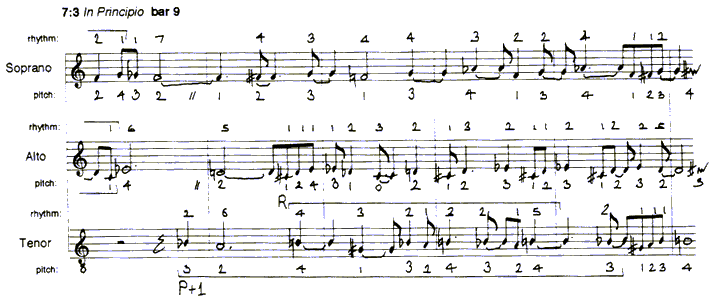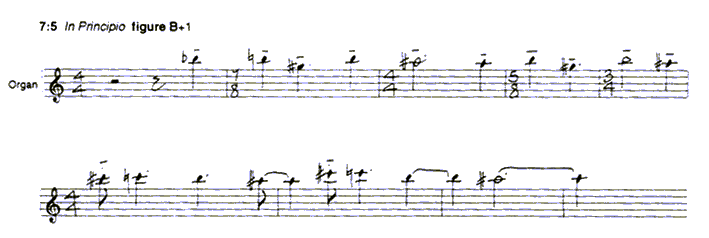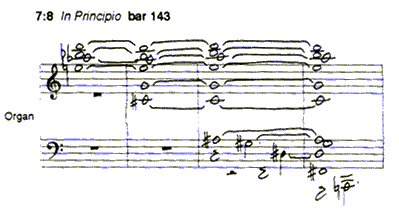rhoadley.net music research software blogs
introduction through the sharp hawthorn in principio four archetypes sextet only connect shilbottle cobbles miscellaneous pieces scena concertino three pieces for two pianos conclusions bibliography
7
In Principio
for choir and organ/choir and brass
- Composed: Charterhouse, September 1988/9
- Performed: BBC Singers, conducted by John Poole
- BBC Singers workshop, Huddersfield Contemporary Music Festival
- November 1991
7.1 Introduction
In Principio was originally written for the Charterhouse Chapel Choir. It was never performed at the School. It was entered, in a specially prepared arrangement for choir and brass, in the Lewis Silkin Young Composers Competition of 1990, in which it was placed second, was highly commended, but not performed. It was finally performed, in its original form and under the aegis of the SPNM, in the workshop mentioned above.
As the piece was originally intended for a relatively small choir (about 12-15 young people: boys and girls), many 'normal' stylistic features had to be modified for the vocal music, with any 'pyrotechnics' left to the organist. Deliberately, no large melodic leaps or complex rhythms were used. In fact, this intention pushed the music towards the opposite extreme: lines of tight, dense, chromatic counterpoint, which turned out to be just as difficult for young people to sing as the more obviously difficult lines and textures.
The music is very simply organized: alternating sections of choral passages and organ interludes, each comprising a series of homophonic chords over a sustained major tenth or third (depending on available stops) in the pedals.
Each section grows in complexity and vigour: the number of 'voices' in each choral section increases as does the density of the harmony. The organ episodes increase in activity, until a demi-semiquaver figure 'breaks free' of the otherwise homophonic and chordal texture. This spins high over the abysmal pedal notes.
In this way the words in the choral passages describe the 'action' in a fairly conventional way with little or no word-painting. The latter occurs during the episodes for the organ. This method was also appropriate for the original resources for the piece: young, inexperienced voices and a good organist.
After the voices come together for the first words of God: the creation of light, the texture changes, although the material remains dense and chromatic.
Finally, there is a pause before the closing chorale based on some of the original organ music. This is more reflective as God views his creation. The piece ends on the omnipresent tenth.
7.2 Analysis & Compositional Methods
It took some time and many failed attempts to find a suitable sound for the opening choral passages. Knowing the basic sound I wanted, I tried many systems which would create the right texture and process, the most difficult aspect of which was achieving the correct balance between chromaticism and tonality. Eventually, having completed the soprano part to my satisfaction, I began experimenting, using this as the basis for a rhythmic and pitch row, 'transposing' this to form the new entries, as well as elements of the counter-subjects
(see ex 7:1, 7:2, 7:3).
[play examples]


So, the numbers map out as follows, (asterisks indicate altered notes; read this in conjunction with the above ex 7:1 -7:3):
Rhythm
R R
Soprano 3 3 5 4 3 2 1 3 2 1 5 3 1 4 2 4 2 3 1 4 2* 2 1
3 2 1 (1) 7* 4 3 4 4 3 2 2* 4* 1* 1 2 8...
R
Alto 4 3 2 6 1 4 3 2 1 3 2 1 6* 5 1 1 1 1 2 3 2 1
3 2 1 1 2 1 2 2 5...
R
Tenor 2 6 4 3 2 1 3 2 1 5 2 1 1 1...
Pitch
P P (transposed)
Soprano 2 1 3 4 2 1 3 2 1 3 2 1 3 4 2 1 3 2 4 5 3 2 4
3 2 4 3 2 (1) 2 3 1 3 4 1 3 4 1 2 3 4...
P-1 P (transposed) altered.....
Alto 1 4 2 3 2 1 4 2 1 4 2 1 4 2 1 2* 4 3*1 (0 2) 1 2
...order
3 1 2 3 1 2 3 2 3...
P+1
Tenor 3 2 4 1 3 2 4 3 2 4 3 1 2 3 4
This, as usual with modifications (as can be seen), created just the right balance of musical growth, yet using harmonic stasis.
Ex 7:4 shows a short extract with a basic harmonic analysis.
shows a short extract with a basic harmonic analysis.
Just as when writing sixteenth-century counterpoint, composition became even more difficult with the addition of more parts, and the counterpoint suffers because of this.
The interludes for organ include two main elements, a sustained yet rhythmic 'chorale' and a fast decorative idea,
(ex 7:5, 7:6 & 7:7) .


The final chorale,
(figure K, bar 131, ex 1:39), is derived from the first of the organ interludes (ex 7:5).
7.3 Local and Global
The Graphic Analysis shoes very clearly how the piece works on a global level, especially the alternations between choir and organ which, with their reference to antiphony, create a certain air of the archaic which I felt was appropriate to the text and to the group who were originally to have performed it. It also shows the use of certain shapes, especially the rising and falling motion of many of the longer passages, and the way the choir reaches its highest point of pitch during the passage concluding with the cry of Lux, before falling away. Because of the simplicity of the piece, this graphic analysis of this piece is more revealing than many others in the portfolio.
7.4 Meta-Global
The most important meta-global element here is the chorale at
figure K and the big organ chord which occurs at the end of it, (bar 143, ex 7:8 & 1:35d). [play example 7:8]
[play example 7:8]
The chord, which can be related to the chord mentioned in Concertino and Four Archetypes (ex1:37a & 1:38a respectively), (notably the major sixth interval at the root), occurs again explicitly at the opening of Two Pieces for Three Pianos, and also in modified form in the Four Archetypes. The Chorale itself, (figure K, bar 131, ex 1:39), although harmonically solely based around sets of augmented fourths, takes it's mood from the use of contrary motion between the sopranos and altos, and tenors and basses. Moreover, at this point and throughout there are far more explicit tonal references than have been used in any other piece, from the rather perverse chromatically shifting harmonies pointed out in ex 7:4 , to the big D major chord (figure E-1), to the chorale itself. Here, the tension between those passages using almost solely augmented fourths is contrasted with those passages, (bars 138-140, and 147-151), which are based around fourth or seventh chords. In addition, of course, the piece ends on a very firm major tenth based on E flat.
Although many of these tonal elements were used deliberately because of the nature of the choir I was writing for, the experience of doing so quite definitely emphasised to me what could still be achieved using what were in my terms quite simple tonal ideas. The influence of this piece on others following, especially those elements mentioned above, was to be quite obvious.
7.5 Version for Brass & Choir
As has been mentioned above, the piece was originally written for the Charterhouse Chapel Choir and organist, although it was never performed there. Shortly after completing the piece I heard about the Lewis Silkin Competition and very quickly wrote the version for Choir and Brass. Although there are many similarities, a lot of interpretation had to be done as can be imagined, although my personal knowledge of brass instruments helped considerably. The most troublesome parts were obviously the fast moving passages; these had to be quite substantially re-written to accommodate the smaller ranges and limited flexibility of brass instruments. The high chromatic passages around figure J of the brass version were also re-written to fit in with the trumpet's ability to play numerous notes with a similar valve combination. I was able to create series' of chromatic lines which could be played with fairly simple sequences of valve movements. If played correctly, these could also give quite interesting tuning effects.
7.6 Influences
The most obvious influence is Messiaen: I found the sound of his organ music so powerful that his influence was hard to avoid. There is, I feel, also an element of Ligeti in some of the more densely chromatic passages. Mention was made in the section about Scena of the influence of Stravinsky's Canticum Sacrum. The use in that piece of choir and organ, the archaic atmosphere created using polyphony and the quasi-tonal nature of much of the music was at the back of my mind throughout much of the piece, and although I didn't think of it at the time, In Principio's final major tenth must have been influenced by the magical final chord of Symphony of Psalms.
7.7 Judgement
This piece has one of the most basic structures of any in this portfolio, and this basic structure is most openly revealed in the music. This means that its first performance was one of the most best I have experienced. It has a far more immediate effect than most of my pieces. I believe that the music from the Chorale to the end of In Principio is some of the most successful I have written.